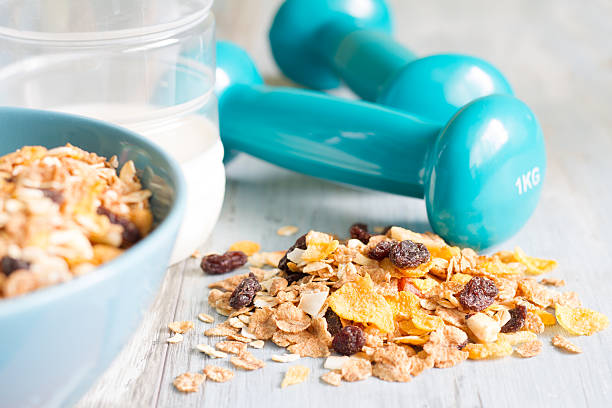You’re insistent on keeping the sugary cereals out of your children’s bowls, and you prefer to bring in breakfast grains with plenty of minerals and vitamins in the packaging: Fortified cereals. But does that means they’re healthy? We talked to the Dr. Felicia Stoler, DCN Registered dietitian fitness physiologist, nutritionist, and exercise physiologist to get the facts.
What are fortified cereals?

All fortified foods are enriched with minerals and vitamins that have been manually added instead of naturally occurring naturally. “Fortification came about in the last century as a way of ensuring that illnesses associated with vitamin deficiency were avoided,” Stoler says. Stoler. “Fortification went into foods that are considered ‘staples’ and were affordable for most people.” That’s why the items which are often fortified are important ingredients like cereal grains, cereals, milk for babies, and baby formula juice. The majority of fortified cereals are pre-packaged and ready to drink cold. You may also find oatmeal that is fortified and hot cereal in the grocery store.
Ready-to-eat cereals with whole grains as their primary ingredient must be fortified, unless the cereal is 100 % whole grain, says the USDA. “All wheat derived foods [in the U.S.] are fortified with B vitamins, folic acid and more,” Stoler adds. Stoler. Therefore, even though juice and milk are the most often fortified with calcium and vitamin D, in the U.S. (hooray for strong teeth and bones), fortified cereals contain many other minerals and vitamins.
The difference could be huge. For example one cup of cereal made from normal wheat can provide around 10 percent of your daily recommended iron intake. A similar amount of cereal that is made from Fortified wheat could easily meet 100 % of your iron consumption, with up to 40 mg in a cup. Here are some of the most popular fortifiers and the reasons they’re healthy for you:
- Vitamin B: These include thiamine as well as riboflavin, niacin and thiamine (vitamins B1 as well as B2 as well as B3) and B6, and B12. Their main function is to enhance energy however they also help the blood vessels, the nervous system, and the skin.
- Folic acid Folic acid: U.S. is among the handful of countries which require wheat flour, which is a staple ingredient in packaged cold cereals to be enriched by folic acid. It is the synthesized form of folate. Also called vitamin B9, folate is utilized to make new cells within the body. It is particularly beneficial for women expecting a baby as it can prevent birth defects, specifically neural tube defects, such as spina bifida or anencephaly according to CDC.
- Iron Hey, Brain Food. Iron is a great ingredient to aid the development of our brains and helps prevent anemia it also improves the immune system and improves the health of blood.
- Calcium The study conducted by researchers at the ARS Children’s Nutrition Research Center discovered that children who wolf up a cup of calcium-enriched cereal in the morning absorb their daily calcium intake more easily, without reducing their iron absorption. Additionally, it is essential for bone health and healthy teeth having a sufficient intake of calcium during childhood may help prevent osteoporosis later on in the course of.
- Zinc Recovery from wounds, immunity health, metabolic function This nutrient can do everything. It’s also an effective treatment for symptoms of colds, according to The Mayo Clinic.
- Vitamin A Making sure you get your recommended dose of Vitamin A essential for eye health as well as cell development as well as immunity system strength, and function of organs, especially those of the lungs, heart and kidneys, as per the National Institutes of Health.
- Vitamin C Sometimes referred to as ascorbic acid Vitamin C is widely utilized for cold remedies (though it’s not doing you much good to start taking it if you’re already sick). Vitamin C is a fortified ingredient in many foods. C can be a powerful antioxidant which helps in the development of cartilage, blood vessels, collagen and muscle, according to Mayo Clinic. It also helps protect our body from the effects of free radicals that are involved in the development of heart disease and cancer. Vitamin C can also help the body retain iron.
- Vitamin D The nutrient Vitamin D crucial for the normal division of cells and is most well-known for its role in promoting the absorption of calcium. (That is why it’s a staple in nearly every milk produced in the U.S.)
- Pantothenic acid Similar to all B vitamins Vitamin B5 converts carbohydrates into glucose that the body converts into energy (meaning eating a bowl of cereal with this vitamin in it is great for tired youngsters to get up). It is also essential for the development of blood red cells, as well as certain glands and hormones as well, according to Mount Sinai Hospital.
- Magnesium Its 300+ enzymes found in our bodies that are affected by magnesium are able to control blood sugar levels and blood pressure, to ensure good nerve and muscle function according to the Harvard University’s T.H. Chan School of Public Health. Magnesium is also a great aid to help muscles contract, and the heart beats continuously.
Is Fortified Cereal Healthy?

“fortified cereals can be part of a healthy diet,” claims Stoler. If you don’t have an everyday multivitamin or eat a balanced and balanced diet, fortified cereals are an easy method to get your daily mineral and vitamin levels up. They are also beneficial for children, pregnant women and vegetarians. “Almost all cereals have added vitamins which is why the topic of being healthy becomes a matter of the most popular. What are you looking at on a label of a food item? For me, it’s fiber and calories.”
The answer is that it all is dependent upon the type of cereal. Certain cereals lack nutrition, or are loaded with calories or sugar (we’re taking a look at Cap’n Crunch, the most beloved of all). The most healthy fortified cereals are those made from whole grains and are high in protein and fiber. A lot of protein and fiber to start your day = feeling content until lunchtime. What is the amount of fiber you should be aiming to achieve? “I recommend having cereal with at least 4 to 5 grams of fiber per serving,” Stoler advises. Stoler.
There are Potential Downsides of fortified cereals
Although there are benefits of taking fortified cereals, it’s technically possible to consume too much minerals and vitamins. However, according to the Cleveland Clinic, it’s not something you should be worried about. A stomach upset could be a short-term result of eating too much minerals and vitamins. In the long term effects of eating too much (namely the intake of vitamins A and niacin, as well as zinc) are skeletal and liver damage as well as a weakening of the immune system. If you’re worried, take your diet into consideration. If your diet is balanced it may be possible to avoid supplements or multivitamins altogether and decrease the chance of overdoing it by taking an enhanced cereal.
However, if you stay clear of cereal purely because of the carbs, then you may consider rethinking your choices. “Too many people get hung up on carbs or added sugar,” Stoler says. Stoler. “Cereals are from grains, which means they will have carbs, which equals grams of carbs and sugar on the label.” Therefore do not go crazy avoidance of sugar or carbs in fortified cereals (unless you’re on keto or another diet that is low in carbs)
Try to find a cereal that is high in fiber that is lower in than a teaspoon of sugar you really love eating. (BTW it’s there’s a reason that the American Heart Association recommends that women restrict their daily intake of sugar to 6 teaspoons, and men limit their intake to nine teaspoons per day, which is about 35 to 36 grams respectively…which isn’t too much considering that a soda can contains eight teaspoons of sugar.) And it shouldn’t cause harm to you (or us, at least) to periodically measure out cereal according to the recommended serving size , instead of filling the bowl up to the top.
Shopping for Healthy Cereal? We Like These
“In all fairness, between Kellogg’s, Post and General Mills, they all make some that might be considered healthier than others,” Stoler says. Stoler. Also, there are many options in the grocery store, and don’t have to look too long to locate these. All you need is to know which areas to search for and the things you should be looking for (i.e. higher sugar, more fiber). Tips: Make sure to look upwards when you shop. “I recommend looking at the two shelves at the top of the grocery store. These are where the more nutritious cereals are located.”
Follow IBA to read more articles about health and beauty.









